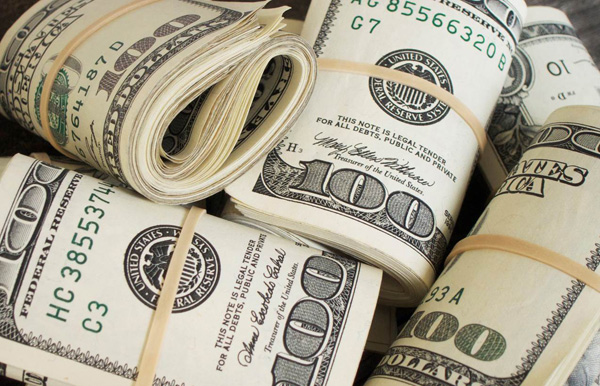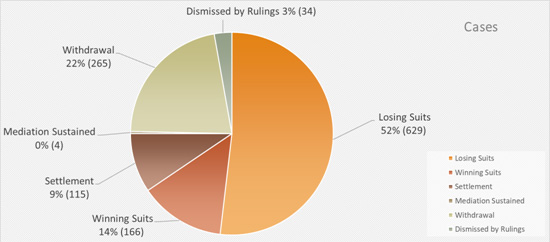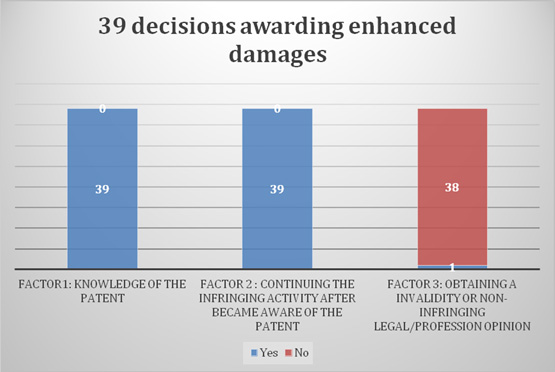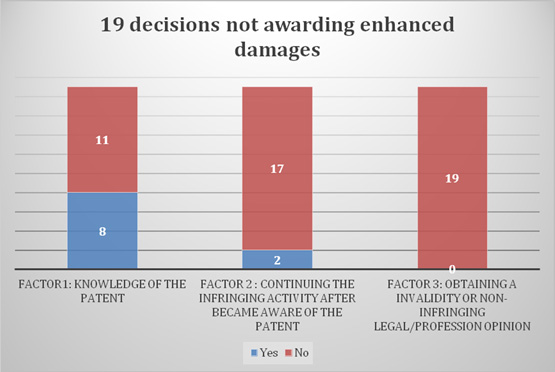|

Source: Pictures of Money; Creative Commons License
Patent Enforcement in Taiwan
A patent owner is entitled to an exclusive right that prevents others from making, using, selling, offering for sale, or importing the patented invention without his permission. Taiwanese patent law makes civil remedies available to a patentee if others infringe his patent. In a situation where infringement has been established, a patentee is allowed to seek an injunction, permanent or preliminary, preventing infringers from manufacturing or selling infringing products. In addition to injunctive relief, a patentee can also pursue monetary damages. When a patentee seeks monetary damages, however, it is not always easy for the patentee to establish the actual damages they have sustained. As such, in terms of monetary damages, the first section of Article 97 of the Taiwan Patent Act provides several ways for the patentee to calculate damages. Under the statute, patent infringement damages can be determined based on one of the following methods if the patentee has provided sufficient evidence.
1. Actual damages and lost profits:
As a starting point, the court may award the patentee actual damages and loss of profits suffered due to infringement.
2. The difference in the patentee’s profits before and after the infringing activities:
Most patentees, however, have difficulties in proving the actual damages they have sustained. So an alternative approach is to seek damages based on lost profits due to the infringing activity. In other words, the patentee has to provide evidence of sales he would have made if the infringing products had not been on the market. The difference between sales before and after the infringement is deemed to be the total amount of compensation that a patentee may request.
3. Profits gained by infringers:
Yet another way to calculate damages is available to a patentee, where courts will look at profits made by the infringer as a result of infringing activities. When claiming profits derived from the infringing activity, the patentee must then provide a detailed calculation of the profits made by the infringer.
4. Reasonable royalties:
If none of the above approaches to calculating damages are feasible for the patentee, Taiwan patent law allows courts to award the patentee monetary damages based on a reasonable royalty. Although the provision for damages based on reasonable royalties was not codified in the Patent Act until 2011, courts in Taiwan allowed patentees to adopt this approach to calculating damages in patent infringement cases previously to this. In light of the wording of the statute, the patentee has to prove “the amount calculated on the basis of reasonable royalties that may be collected from exploiting the invention patent being licensed.” A reasonable royalty is generally the amount that a licensee would agree to pay after negotiating with the patentee. The Legislative Yuan, Taiwan’s Congress, has made it clear that a reasonable royalty is not the ceiling or floor of damages that can be awarded. As such, when assessing patent infringement damages based on reasonable royalties, the court may award the patentee compensation on the basis of but not limited to the established amount of reasonable royalties.
Intentional patent infringement and enhanced damages under the Taiwan Patent Act
The Taiwan Patent Act provides a wide variety of damages that a patentee may seek in terms of compensation. Apart from injunctive relief and compensatory damages, the statute also provides enhanced damages that allow courts to grant patentees damage awards in an amount that is greater than the established damage amount. The current language of the second paragraph of Article 97 of the Taiwan Patent Act states: “Subject to the preceding paragraph, where the infringement is found to be intentionally committed, the court may, upon the request of the plaintiff, award a damage to the plaintiff, of which the amount does not exceed three times of the actual damage that has been proved by the plaintiff.” Therefore, by awarding the patentee up to three times the amount of damages established by the patentees, enhanced damages function to deter infringers from engaging in willful and intentional infringement.
The provision of enhanced damages was codified in the Taiwan Patent Act in 1994. Because the Congress decided to delete penal sanction provisions to patent infringement codified at that time, the provision of enhanced damages was thus added and included in the law to serve as an alternative means to punish intentional infringers. Originally the statute allowed the patentee the right to claim compensation greater than the loss suffered but not exceeding twice the amount of proven damages. In 2001, the provision was amended to give patentees the right to claim enhanced damages in an amount up to three times the amount of harm suffered. Although the enhanced damages clause was deleted in 2011 for a short period of time, it was eventually recodified into the law in 2013.
Establishing willful infringement has always been a thorny issue in patent infringement lawsuits. The United States Patent Act, 35 U.S.C. § 284, gives courts discretion to award enhanced damages in patent infringement lawsuits. The United States Court of Appeal for the Federal Circuit held in In re Seagate Tech., LLC, 497 F.3d 1360 (Fed. Cir. 2007), that “willful infringement permitting enhanced damages requires at least a showing of objective recklessness.” Factors for the courts to consider in determining whether the infringement was willfully committed include: 1. Whether the infringer deliberately copied the ideas or design of another; 2. Whether the infringer, when he learned of the patent in question, investigated the scope of the patent and formed a good-faith belief that it was invalid or that it was not infringed; 3. The infringer's behavior as a party to the litigation; 4. The scale of the accused infringer's business or holdings and their financial condition; 5. The closeness of the case; 6. The duration of the infringer's misconduct; 7. Whether the infringer took any remedial action; 8. Whether the infringer had a “motivation [to] harm” the patentee; and 9. Whether the infringer attempted to conceal their misconduct. (See Read Corp. v. Portec, Inc., 970 F.2d 816, 826-27 (Fed. Cir. 1992)).
Patent Infringement Lawsuits in Taiwan: A Quick Overview
Generally, if the defendant already had knowledge of the patent at issue in the patent infringement lawsuit, courts in Taiwan are much more likely to hold that the defendant intentionally infringed the patent. If it is known that the defendant had previously cooperated with the patentee or that the defendant had an employment relationship with the patentee, this is considered as proof of the defendant’s knowledge of the patent (See case number: Supreme Court 98 (2009) Tai Shang Zi No. 1824; Taiwan High Court Year 97 (2008) Zhi Shang Geng Yi Zi No. 6; Taiwan High Court year 93 Shang Yi Zi No. 8). In addition, if the defendant has previously infringed other intellectual property rights pertaining to the plaintiff, the courts will likely hold that the defendant intentionally infringed the patent (See case number: Taiwan Intellectual Property Court Year 98 (2009) Min Zhuan Su Zi No. 1; Taiwan Intellectual Property Court year 97 (2008) Min Zhuan Su Zi no. 66). However, what if the defendant has received a cease and desist letter from the patentee? Is a notification of a patent or a cease and desist letter from the patent owner sufficient to prove the fact that the defendant’s infringement was intentionally committed?
In order to understand and analyze the factors that courts may take into consideration in determining intentional patent infringement, I conducted a detailed survey of legal precedents and analyzed the evidence and facts that affect courts’ determination of intentional infringement. The results of the findings can help us to understand and clarify the requirements for proving intentional infringement.
Statistics from Taiwan’s Intellectual Property Court (hereinafter the “IP Court”) show that there have been 1,213 patent litigation decisions rendered by the IP Court on the first instance from July 1st, 2008, the date of the IP Court’s establishment, to September 30th, 2017. Among those decisions, 166 out of 1213 were held for plaintiffs, while 629 were dismissed by the IP Court (See Figure 1).
【Figure 1:State of the Patent Cases by the IP Court at the First-Instance Level (July,2008~Sep.,2017)】

【Statistics from Taiwan Intellectual Property Court】
Predicting the court’s behavior
To clarify the evidence required and other factors that affect courts’ determination of whether a patent was intentionally infringed by the defendant, I carried out an empirical study on all patent lawsuit civil decisions from the Supreme Court and the IP Court. I used the judicial decision database created by Taiwan’s Judicial Yuan to search and analyze. The search scope of the research includes civil decisions by the Taiwan IP Court and the Supreme Court. I put the words “patent (in Chinese)” in the search bar of the category of the cases and “punitive (also in Chinese)” in the keyword search bar to run the research. The scope of period includes decisions issued from July 1st, 2008 to November 30th, 2017. 142 decisions came up based on the search method and scope. Out of the 142 decisions, 138 of which were delivered by the IP Court and five by the Supreme Court (see Chart 1).

【Chart 1:Patent Civil decisions made by Taiwan IP Court and the Supreme Court
(July 1st, 2008~Nov. 30th,2017)】
Among the 142 decisions, there were 58 cases in which the plaintiffs prevailed and the court confirmed the patent infringement. In 39 cases out of the 58 decisions, courts awarded enhanced damages to the plaintiffs. Three crucial factors were considered in the survey of each of those cases in which enhanced damages were granted. First, whether the defendant had actual knowledge of the patent prior to being served with the plaintiff’s complaint. Second, whether the defendant continued the alleged act after he became aware of the patent. And lastly, whether the defendant had ever sought legal/professional advice that formed the defendant’s firm belief in invalidity or non-infringement? All of the defendants in the 39 cases were found to have actual knowledge of the patents at issue before receiving the complaint from the plaintiffs. All of the defendants continued the alleged infringing activity after learning of the existence of the patent. Only one defendant raised a defense that the alleged infringing activity was non-infringing, based on professional/legal opinions, and requested that no enhanced damages should be awarded in the event that the activity was found to be infringing (see Figure 2).
【Figure2: Determining factors for courts to find an intentional infringing activity
in 39 cases awarding enhanced damages】

In the remaining 19 cases in which the defendants were found to have infringed the patent but the infringements were not judged to have been committed intentionally, courts also considered these three factors in disagreeing with plaintiffs’ claim of enhanced damages. Among the 19 cases, 11 defendants did not have actual knowledge of the patent before the lawsuits, while in six of them the defendants had received cease and desist letters from the plaintiff and two of them had initiated a revocation procedure with the Taiwan Intellectual Property Office to invalidate the patent before the lawsuits. Moreover, in 17 of the cases, the defendants immediately stopped the alleged infringing activity after becoming aware of the patent. Although there were two cases in which the defendants continued the alleged infringing activity after learning of the existence of the patent, courts found that the infringement was not intentionally committed by the defendants. One defendant tried to design around to avoid infringement after learning of the patent. Although the design around eventually failed and the defendant was found liable for infringement, the court held that the fact that the defendant tried to design around was sufficient to prove that the defendant did not manufacture the infringing products with the intention to infringe the plaintiff’s patent (see case number: Taiwan Intellectual Property Court Year 102 (2013) Min Zhuan Shang Zi No. 3). In the other case where the defendant did not stop the alleged infringing activity, the court reasoned that because the defendant had already filed an action to invalidate the patent and start a revocation procedure before Taiwan’s Intellectual Property Office, the manufacture of the products by the defendant was without an intention to infringe plaintiff’s patent (see case number: Taiwan Intellectual Property Court Year 98 (2009) Min Zhuan Shang Zi No. 87). Last but not the least, all the defendants in the 19 cases did not obtain professional legal advice of invalidity or non-infringement of the patent (see Figure 3).
【Figure 3: Determining factors affecting courts in finding an intentional infringing activity in 19 cases where
the court found the patent was not willfully infringed and no enhanced damages were awarded】

Summary and Observations
The results of the survey suggest that the first and second factors have the most profound impact on the courts’ determination of intention. In deciding whether a patent infringement is intentional in its nature, courts look into whether the defendant had actual knowledge of the patent before receiving the complaint, and whether the defendant continued the alleged act after becoming aware of the patent. If the defendant had a belief that the patent was invalid, the best way, based on the observations of this survey, for the defendant to get away from being held “intentional” is to initiate an invalidation action before Taiwan’s Intellectual Property Office. While undertaking an invalidation action might not be a conclusive factor for courts to find willfulness, this will allow the defendant to argue that he did not infringe the patent intentionally. In addition, designing around can also be persuasive evidence to defend against a plaintiff’s claim of intentional infringement.
 |
|
| Author: |
Lung-sheng Chen |
| Current Post: |
Associate Professor, Department of Law, National Chung Hsing University |
| Education: |
J.D., Washington University in St. Louis
LL.M., Washington University in St. Louis
LL.M., National Chung Cheng University |
| Prior Posts: |
Attorney at Law, Formosa Transnational |
|
|
|
| Facebook |
|
Follow the IP Observer on our FB Page |
|
|
|
|
|
|

